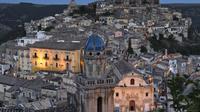Ragusa walking tour
Ragusa, Italy
Trip Type: Walking Tours
Duration: 3 hours
The city of Ragusa in Italy rises out of rough spurs and river crags on an urban strip with steep declivity. It was an elect ground for architects who accentuated natural irregularities, creating unique connections and monumental effects.
More About This Activity All Walking Tours →
The city of Ragusa in Italy rises out of rough spurs and river crags on an urban strip with steep declivity. It was an elect ground for architects who accentuated natural irregularities, creating unique connections and monumental effects.
The city is divided into two important areas: Ragusa Superiore, founded after the earthquake in 1693, and Ragusa Inferiore, the original site. The latter is called Ibla nowadays because, at the beginning of the 20th century, some archaeologists discovered the ruins of Hybla, a village founded by Siculi people about 3000 years ago. Ragusa Superiore and Ragusa Inferiore were separated towns until 1926 when Mussolini decided Ragusa had to be the provincial capital.
We start our visit with a stop to see the panoramic view and the church of Santa Maria delle Scale, whose interior has one nave in gothic catalan style (15th century). Going down toward the old city you find Palazzo della Cancelleria, the Church of Madonna dell’Itria, whose bell tower is decorated by tiles which reproduce Iris plants, and Palazzo Cosentini and its two facades joined by a statue of San Francesco di Paola. Arriving in Piazza della Repubblica you see the church of the Anime Purganti. Its central portal door is decorated by dadoes and the souls in purgatory and on its sides two shell niches hold statues of saint Peter and Saint Paul. Going along via Capitano Bocchieri, you arrive in Piazza Duomo where, at the end of a monumental staircase closed by a wrought iron gate, there is the Church of San Giorgio, a work by Rosario Gagliardi, the most important architect of the Val di Noto. The facade is considered the best example of late baroque art: 3 levels convex in the center and concave to sides animated by free Corinthian columns.
We start our visit with a stop to see the panoramic view and the church of Santa Maria delle Scale, whose interior has one nave in gothic catalan style (15th century). Going down toward the old city you find Palazzo della Cancelleria, the Church of Madonna dell’Itria, whose bell tower is decorated by tiles which reproduce Iris plants, and Palazzo Cosentini and its two facades joined by a statue of San Francesco di Paola. Arriving in Piazza della Repubblica you see the church of the Anime Purganti. Its central portal door is decorated by dadoes and the souls in purgatory and on its sides two shell niches hold statues of saint Peter and Saint Paul. Going along via Capitano Bocchieri, you arrive in Piazza Duomo where, at the end of a monumental staircase closed by a wrought iron gate, there is the Church of San Giorgio, a work by Rosario Gagliardi, the most important architect of the Val di Noto. The facade is considered the best example of late baroque art: 3 levels convex in the center and concave to sides animated by free Corinthian columns.
Crossing Piazza Duomo, enclosed by late baroque and neoclassic edificies, among which are the Circolo di Conversazione and Palazzo Donnafugata, you reach piazza Pola. Here you find the Church of San Giuseppe, built on the ruins of the church of San Tommaso. Its beautiful central door is flanked by statues and Corinthian columns and above it there is a huge central window with grated shutters. Leaving corso 25 aprile you reach the Giardino Ibleo, a beautiful park which hosts inside 3 churches (San Vincenzo, San Giacomo and Cappuccini church) and the Gothic style portal door of the original church of San Giorgio, survived the earthquake in 1693.
« Go Back

